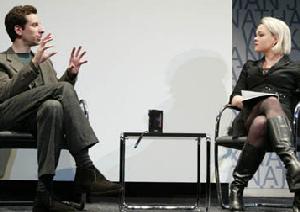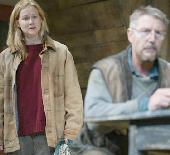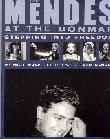SEARCH
CurtainUp
REVIEWS
FEATURES
NEWS
Etcetera and
Short Term Listings
LISTINGS
Broadway
Off-Broadway
BOOKS and CDs
OTHER PLACES
Berkshires
London
LA/San Diego
DC
Philadelphia
Elsewhere
QUOTES
On TKTS
LETTERS TO EDITOR
FILM
LINKS
MISCELANEOUS
Free Updates
Masthead
NYC Weather
A CurtainUp Review
Sight Unseen
|
You mean there are people on Park Avenue or in Tokyo who have walls in their living rooms especially reserved for the latest Waxman, Number 238?. . .these poor, unsuspecting -- rather, rich unsuspecting--patrons of the arts have bought, sight unseen, a painting you have not yet painted?---Nick Yes --Jonathan, the painter whose work has achieved this "sight unseen" status. |

Ben Shankman as Jonathan and Ana Reeder as Grete
|

Laura Linney as Patricia and Byron Jennings as Nick
|
Director Daniel Sullivan has staged this revival with his usual sensitivity. It's a beautiful production that brings out all the subtleties that tie together the story of a life defining love affair with an artist's struggle to deal with his Jewish identity and the fact that fame has not made him immune to insecurity and a sense of having lost his way.
Best of all, this Sight Unseen has Laura Linney as the centerpiece of a superb cast. Linney played the smallest but disturbingly memorable role of a young German journalist in the 1992 production. She is now the more mature Patricia who still carries the scars of her youthful affair with Jonathan, the painter who rejected her even though the relationship marked the turning point in his development as an artist. It's a splendidly luminous performance.
The play could be summed up as "successful American painter detours from a London retrospective of his work to visit the lover he hasn't seen for fifteen years in the spartan farmhouse where she lives and works with her archeologist husband." But that only hints at the conflicted feelings that simmer beneath the initially polite interchanges and the way Margulies plunges his characters --and us with them -- into the more controversial subtexts vis-à-vis race and modern art.
The first two scenes are conventionally sequenced, beginning with the get-together which is prompted by Jonathan's phone call out of the blue and Patricia's responding to that call with an invitation to come to dinner and spend the night -- both the call and the invitation prompted by impulses neither quite comprehends. Patricia's question about why he came ("Do you have some sort of agenda or something?"), brings a vague "I Wanted to see you again. . .it felt somehow. . .incomplete" and then the admission that he wanted to apologize. When Jonathan, sensing her hostility, asks why she invited him to her home she can only come up with "you caught me off guard."
Packed as it is with telling bits and pieces of information that point to the labyrinth of unburied pain Patricia and Jonathan and her husband Nick (Byron Jennings) must navigate, that first scene typifies Margulies' ability to find the right mix of humor and seriousness to tell an involving story. A first glance at your program may make the non-linear plot progression seem gimmicky or confusing; the latter borne out by the two women sitting next to me who seemed to have a hard time trying to figure out the scene sequences in their programs. Being familiar with the play, I assured them, that it would all sort itself out. And so it did. The forward-backward-forward-further backward jumps eventually lead to the logical time and place in the story, the beginning of the relationship that ended without proper closure.
The real challenge all the leapfrogging poses is less for the audience than the set designer, a challenge Douglas W. Schmidt has met with four richly detailed sets (as just one example of his eye for detail, the Jewish identity conflicted Jonathan's boyhood room includes an image of Anne Frank). What's more, Schmidt has achieved the scenery shifts so smoothly that, except for some rumbling noises from behind the striking photo-montaged intra-scene curtain, the alternating sets appear almost as if by magic. The stagecraft is further enhanced by Pat Collins' lighting and John Gramada's original music and sound design.
Ms. Linney's Patricia is, as I've already indicated, extraordinary. The enthusiastic schoolgirl who posed for Jonathan to make extra money is still evident in the thirty-ish expatriate archeologist who married an English colleague when her student visitor's permit ran out. Equally evident is the wounded spirit that underlies her amused comment that Jonathan's wife should thank her for laying the groundwork for his marrying a shiksa ("I was the pioneer. . .the sacrificial shiksa"). Look closely and you'll see the flicker of pain when she hears of his impending fatherhood and when he mentions that he's previously been in London, obviously without any urge to look her up. Dressed to unstylish perfection by Jess Goldstein (whose outfits are equally on target for Shenkman, Reeder, Jennings) Linney looks like a woman close to forty who's let herself go-- yet she's a believably young and beautiful golden girl in the scenes going back to the student romance.
Good as Linney is, this is very much an ensemble piece. Ben Shenkman adds another on target performance to a gallery of roles that include the post graduate mathematician in Proof, also directed by Daniel Sullivan, and the recent HBO film of Angels In America. As a Jewish boy from Brooklyn who has climbed the art world's tallest ladder, he comes off as both at odds with himself and arrogant.
Byron Jennings, cast against type as Nick (he usually plays more elegant, imposing men), is absolutely splendid, adding a Pinteresque darkness to the shy, somewhat peculiar Englishman who is as wounded by Patricia as she was by Jonathan. Nick's veiled anti-Semitism is just a precursor to the scene at the top of the second act, when his taciturnity explodes into an attack on Jonathan specifically and modern art in general.
The play's more searing anti-Semitic implications are left to Grete, the German art critic played with an aptly irritating accent by Ana Reeder. As Nick's hostility explodes at the farm house, so the interview starts out respectfully enough but becomes increasingly uncomfortable as Grete relentlessly probes the connection between Jonathan's art and his Jewishness. The final straw comes with her bringing up rumors about his methods of self-promotion. The interview paints neither Jonathan or Grete in a sympathetic light; thus, when he accuses her of "Jew-baiting " and she is left upset and with an incomplete tape, we are, as with everything else in this play, left to draw our own conclusions.
Ultimately, all the characters' motivations remain ambiguous. The vibrant Patricia's explanations for settling into a hardscrabble sort of life and a passionless marriage are somewhat less than persuasive. Jonathan's finding the lost connection he seeks in an early painting rather than through Patricia supports the author's use of the play as an indictment of modern art. It does little, however, to make us see him as more capable of emotional commitment as a mature man than he was when he was still tethered to his narrow-minded familial milieu. Though Nick's abandoning his excessive shyness to act on the aggressive side of his passive-aggressive personality makes for some of the play's sharpest exchanges, the audience is again left to fill in many blanks in his character as well as the marriage.
When you stop to ponder these character ambiguities, you'll find that they make watching this play akin to looking at a painting, an experience that depends on your own interpretation for its fullest satisfaction -- which is no doubt exactly what the playwright intended. Whatever you preference -- plays which close with neatly resolved answers to questions raised or those that leave things more open-ended and force reflection, modern or traditional art -- the acting and staging of this Sight Unseen make it one of Broadway's not to be missed current "sights."
| SIGHT UNSEEN
Written by Donald Margulies Directed by Daniel Sullivan Cast: Laura Linney, Byron Jennings, Ana Reeder and Ben Shenkman Set Design: Douglas W. Schmidt Costume Design: Jess Goldstein Lighting Design: Pat Collins Original Music & Sound Design: John Gromada Running time:2 hours and 10 minutes, including one 15 minute intermission. Biltmore Theater, 261 W. 47th St. (Broadway/ 8th Ave) 212/239-6900 From 5/06/04 to 7/11/04extended to 7/25/04; opening 5/25/04. Tues through Sat @ 8:00PM, Sat & Sun @ 2:00PM, Sun @ 7:00PM; (Starting 6/22/04) Tues through Sat @ 8:00PM, Wed, Sat, & Sun @ 2:00PM $81.00, $76.00, & 51.00; (Wed Mat) $71.00, $66.00, & $51.0. Reviewed by Elyse Sommer based on performance |





 div class="smaller">6, 500 Comparative Phrases including 800 Shakespearean Metaphors by
div class="smaller">6, 500 Comparative Phrases including 800 Shakespearean Metaphors by CurtainUp
's editor.Click image to buy.
Go here for details and larger image.



